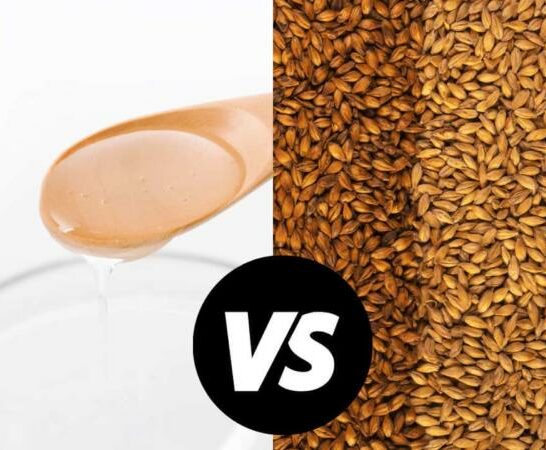Malt powder and malt syrup can both be used for multiple reasons in the kitchen.
However, finding when to use malt powder instead of malt syrup and vice versa can be tricky.
Read on and find the advantages and disadvantages between the two ingredients.
Malt syrup vs malt powder?
If you compare malt syrup to malt powder in bread making, there are several advantages and disadvantages to both. Malt syrup is incredibly sticky and thick and can be cumbersome to use. But, it provides a moistness to your bread and rich dark color. Malt powder is easier to use and can help the bread rise if it has active enzymes. But, the powder lacks the dark coloring and some of the moisture that the syrup provides.
What is Malt?
Malt syrup and malt powders are generally made from barley. However, malting is a specific process when the barley is treated with water and begins to sprout.
The syrup and powders are made from these sprouts.
The sprouts hold some active enzymes that help in brewing and breadmaking desirable for flavor and color.
These flavors are also commonly known in malt balls like the candy Whoppers or malted drinks like Ovaltine.
Malt has a distinctive and recognizable flavor often desired in bread and brews.
For this reason, it is common for these industries to invest in malt syrups and powders.
Malt Syrup Advantages
As mentioned above, malt syrup is desired in breadmaking for its excellent dark color and delicious malt flavor.
One other advantage of malt syrup is that it provides longer life to the bread before it goes bad.
One of the main desirable traits of malt syrup in breadmaking is the rich dark color. This is not too difficult to understand for those who have seen malt syrup.
The substance is generally incredibly thick, sticky, and darkly colored.
Because of the dark color in the syrup added to the dough, bread, bagels, and other baked goods generally come out with a darker color.
This dark color adds to the pleasing aesthetic of baking with malt syrup.
Malt syrup helps to provide some added moisture in the baked good that it is used in.
The syrup seems to be better suited to provide this moisture than the powder, which makes sense due to the syrup being a liquid.
One of the best advantages that malt syrup provides lies in the final product’s shelf life. Malt syrup provides some natural preservatives to whatever it is baked into.
So, when using syrup, it is helpful that the goods last a little longer than other baked goods.
Malt Powder Advantages
The most significant advantage of malt powder is based on the ingredient’s convenience.
Malt powder is generally easier to use than malt syrup because it is not sticky or hard to measure.
Malt powder is made from malt syrup and has many of the same advantages.
It can also provide a darker color, but not as dark as the syrup, and it still offers delicious malt flavoring to bread recipes.
Another distinct advantage of malt powder is that it comes in two different types. Malt powder can come in diastatic and non-diastatic powders.
Diastatic malt powder is rarer and fantastic for breadmaking. Diastatic malt powders contain enzymes that help convert starches into sugar.
These added sugars provided by the enzymes offer two distinct advantages.
First, converting starches to sugars helps the bread in the rising process.
In essence, the added sugars help the yeast, so the bread rises even more and is deliciously fluffy. The second advantage is that added sugars mean a sweeter final product.
Diastatic malt powder uses these enzymes to help the bread become sweeter and soft. Using the diastatic malt powder, you may never go back to baking without it.
Non-diastatic malt powder does not contain these enzymes. Though it will not aid in the rising process, it still provides delicious malt flavor and dark coloring to baked goods.
Non-diastatic malt powder is also used in malted drinks, milkshakes, and candies. It provides a distinct flavor to these other types of desserts.
Malted Milk Powder
Do not be confused by malted milk powders often provided by brands like Carnation, Ovaltine, and others. Malted milk powders are not the same as malt powder.
While malted milk powders can still be added to baking and other baked goods as an added flavor, it is essential to know that these products are different than the others mentioned above.
The powdered milk inside these powders dilutes and changes the uses of the malted milk powders compared to other malt powders.
So, one must be careful not to use malted milk powders to replace other malted powders.
Frequently Asked Questions About Malt Syrup vs Malt Powder
Are malt powders and malt syrups interchangeable in recipes?
Malt powder and malt syrup can be used interchangeably on many occasions. However, it is crucial to ensure that your measurements are accurate. The best practice is to use the ingredient that the recipe asks for.
What if I use non-diastatic malt powder instead of diastatic?
While the recipe may still turn out, your final product will be much denser and not as fluffy. This is because the diastatic powder helps the dough rise. Also, because of the added sweetness from the enzymes, using non-diastatic powder could affect the bread’s sweetness.
Conclusion
Ultimately, malt syrup and malt powder are both great ingredients to add to your bread.
I would suggest having a small portion of each and using them in different recipes until you find the recipe and ingredient you like most.
After you find that perfect recipe, make sure always to have your malt syrup or malt powder handy.

